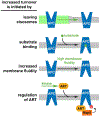Regulation of nutrient transporters by metabolic and environmental stresses
- PMID: 32200208
- PMCID: PMC7501145
- DOI: 10.1016/j.ceb.2020.02.009
Regulation of nutrient transporters by metabolic and environmental stresses
Abstract
The yeast plasma membrane is a selective barrier between an erratic environment and the cell's metabolism. Nutrient transporters are the gatekeepers that control the import of molecules feeding into the metabolic pathways. Nutrient import adjusts rapidly to changes in metabolism and the environment, which is accomplished by regulating the surface expression of transporters. Recent studies indicate that the lipid environment in which transporters function regulates ubiquitination efficiency and endocytosis of these proteins. Changes in the lipid environment are caused by lateral movements of the transporters between different membrane domains and by the influence of the extracellular environment on the fluidity of the plasma membrane.
Keywords: Alpha-arrestin; Eisosome; Membrane tension; Metabolism; Nutrient transporter; TORC2.
Copyright © 2020 Elsevier Ltd. All rights reserved.
Conflict of interest statement
Conflict of interest statement Nothing declared.
Figures


References
-
- Quistgaard EM, Low C, Guettou F, Nordlund P: Understanding transport by the major facilitator superfamily (MFS): structures pave the way. Nat Rev Mol Cell Biol 2016, 17:123–132. - PubMed
-
- Yoshikawa K, Tanaka T, Ida Y, Furusawa C, Hirasawa T, Shimizu H: Comprehensive phenotypic analysis of single-gene deletion and overexpression strains of Saccharomyces cerevisiae. Yeast 2011, 28:349–361. - PubMed
Publication types
MeSH terms
Substances
Grants and funding
LinkOut - more resources
Full Text Sources
Molecular Biology Databases

